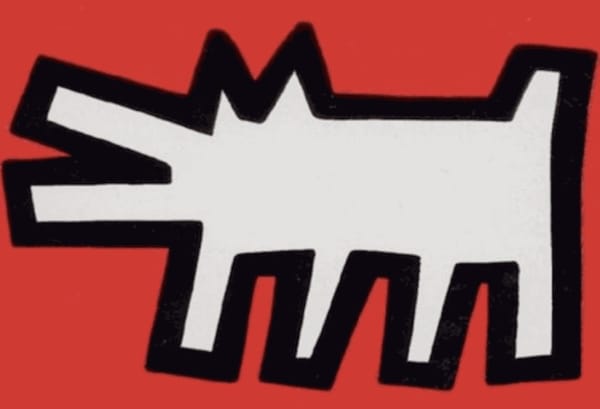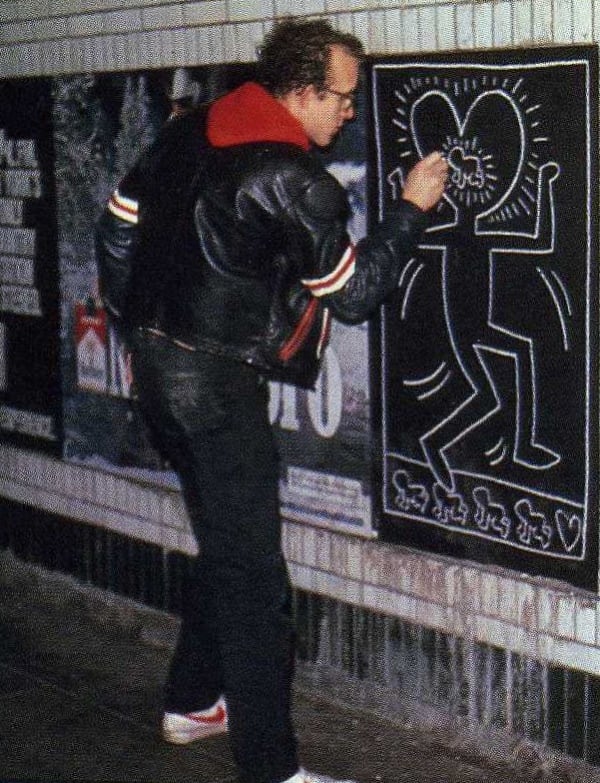-
Overview
“Art is for everybody.”
Keith Haring (1958–1990) was a groundbreaking American artist whose vibrant and accessible artwork transcended the boundaries between street art, graffiti, and high art. Renowned for his bold lines, dynamic figures, and radiant colors, Haring's work is celebrated for its social commentary and accessibility.
Born on May 4, 1958, in Reading, Pennsylvania, Haring developed a passion for art at an early age. He moved to New York City in 1978 to attend the School of Visual Arts, where he became deeply immersed in the city's burgeoning street art scene. Inspired by the energy of urban culture and the graffiti artists around him, Haring started creating his iconic chalk drawings on blank advertising panels in subway stations, quickly gaining attention for his unique style and powerful imagery.
Haring's art is characterized by his distinctive use of bold, thick lines that give life to a repertoire of whimsical and symbolic characters—dancing figures, barking dogs, radiant babies, and flying saucers—which became his signature motifs. Through his instantly recognizable visual language, he tackled significant social and political issues such as AIDS awareness, apartheid, drug addiction, and the fight against oppression.
By the mid-1980s, Haring's work had gained international acclaim, leading to exhibitions in prestigious galleries and museums worldwide. His commitment to public art extended beyond the canvas; he painted murals in hospitals, schools, and public spaces, believing that art should be accessible to all.
Tragically, Keith Haring's life was cut short when he passed away from AIDS-related complications on February 16, 1990, at the age of 31. Despite his untimely death, his legacy endures as an influential figure in contemporary art, inspiring generations of artists and continuing to provoke thought, spark dialogue, and promote social change.
Today, Haring's artwork remains highly sought after and is featured in major museum collections globally, a testament to his enduring impact on the art world and his unwavering belief in the power of art to communicate, educate, and unite.
-
Series
-
All
-
Andy Mouse
-
Apocalypse
-
Bad Boys
-
Chocolate Buddha
-
Fertility
-
Flowers
-
Growing
-
Icons
-
Lucky Strike
-
Ludo
-
Other Prints
-
Pop Shop I
-
Pop Shop II
-
Pop Shop III
-
Pop Shop IV
-
Pop Shop V
-
Pop Shop VI
-
Pyramid
-
Stones
-
The Blueprint Drawings
-
The Story of Red and Blue
-
The Valley
-
Three Lithographs
-
Totem
-
Untitled
-
Untitled Free South Africa
-
White Icons
ExhibitionsNews-

KEITH HARING: IN BETWEEN THE LINES
A DEFINITIVE EXHIBITION OF ICONIC ART April 24, 2024 Read more -

Auction Top 10 from Print Sales
April 18, 2024Yesterday's auction spectacle showcased an array of captivating works, with pieces by iconic artists such as Warhol, Lichtenstein, and Basquiat taking center stage. From Warhol's...Read more -

Sotheby's: March Print Auction Top Lots
March 21, 2024Held March 20 at Sotheby's London, the Prints & Multiples sale showcased the best of contemporary and pop printmaking with stellar results for works by...Read more -

Keith Haring
Pyramids March 13, 2024Keith Haring fearlessly tackled the socio-political issues of his era in his art, standing against racism, homophobia, apartheid in South Africa, and AIDS. Despite delving...Read more -

Keith Haring
A History of the Artist February 27, 2024Renowned for his vibrant and socially charged artworks, Keith Haring developed a distinct visual language infused with signs and symbols, a reflection of his deep...Read more -

The Collection of Sir Elton John
Top Highlights of the Christie's Auction February 22, 2024The highly anticipated Christie's New York Auction of Sir Elton John's collection brings us into the iconic contemporary collection of a living music legend. From...Read more -

Keith Haring Pop Shops and Icons
Collectability and Value February 13, 2024Influenced by the vibrant graffiti scene of 1970s and 1980s New York, Keith Haring emerged as a champion of urban subculture fused with the principles...Read more -

Keith Haring Subway Drawings
A Pivotal Canvas of Political Expression January 23, 2024The New York City subway stations served as both a sanctuary and a canvas for the renowned pop artist Keith Haring . Transforming the vacant...Read more -

KEITH HARING
THE HISTORY OF THE POP SHOP January 7, 2024In the vibrant landscape of 1980s New York City, amidst the dynamic interplay of art, culture, and commerce, Keith Haring established the Pop Shop in...Read more -

2023 In Review
A Look Back December 29, 2023TO WRAP UP THE YEAR, WE ARE TAKING A LOOK BACK AT OUR TOP 10 BEST SELLING ARTISTS OF THE GALLERY. ANDY WARHOL WARHOL'S ART...Read more -

Angel Vasquez on Keith Haring
Haring's Pop Shop September 27, 2023In collaboration with Keith Haring's Universal Language exhibit, Guy Hepner Gallery hosted Angel Vasquez, a former employee of Haring's , to speak on his experiences...Read more
-

















